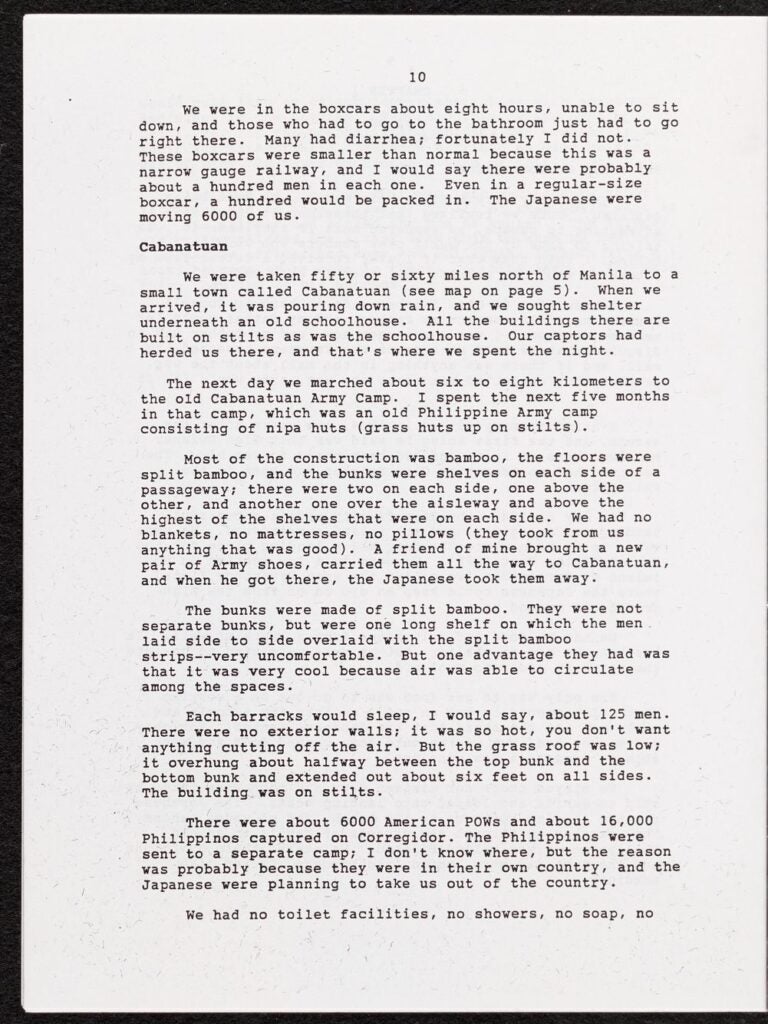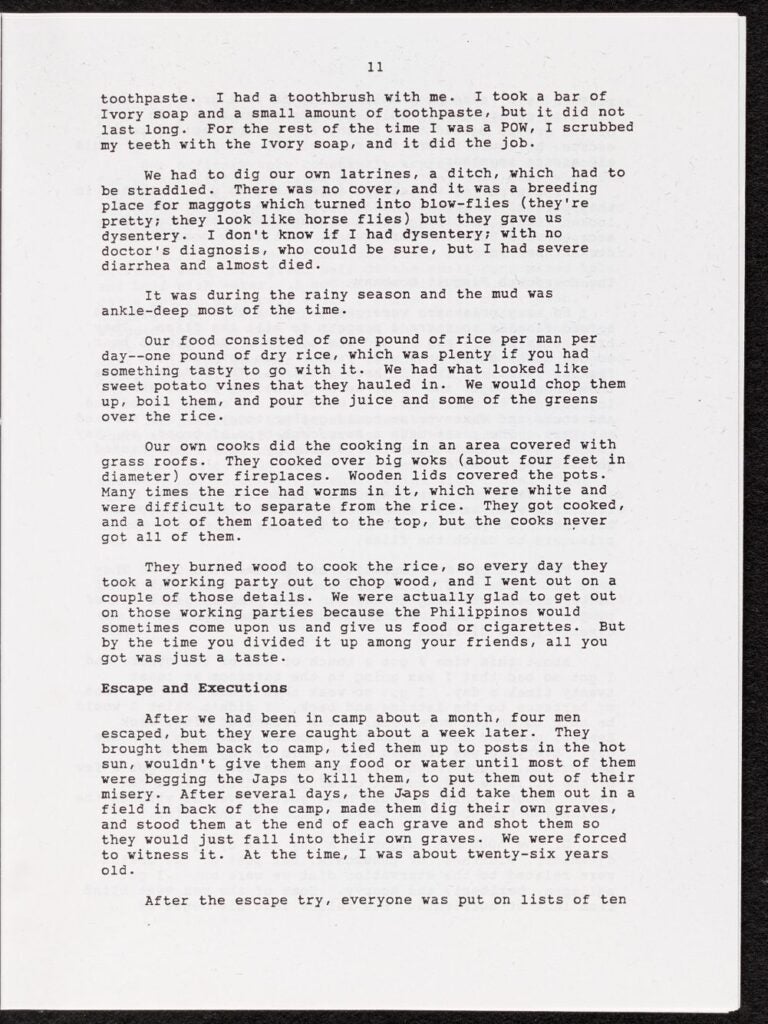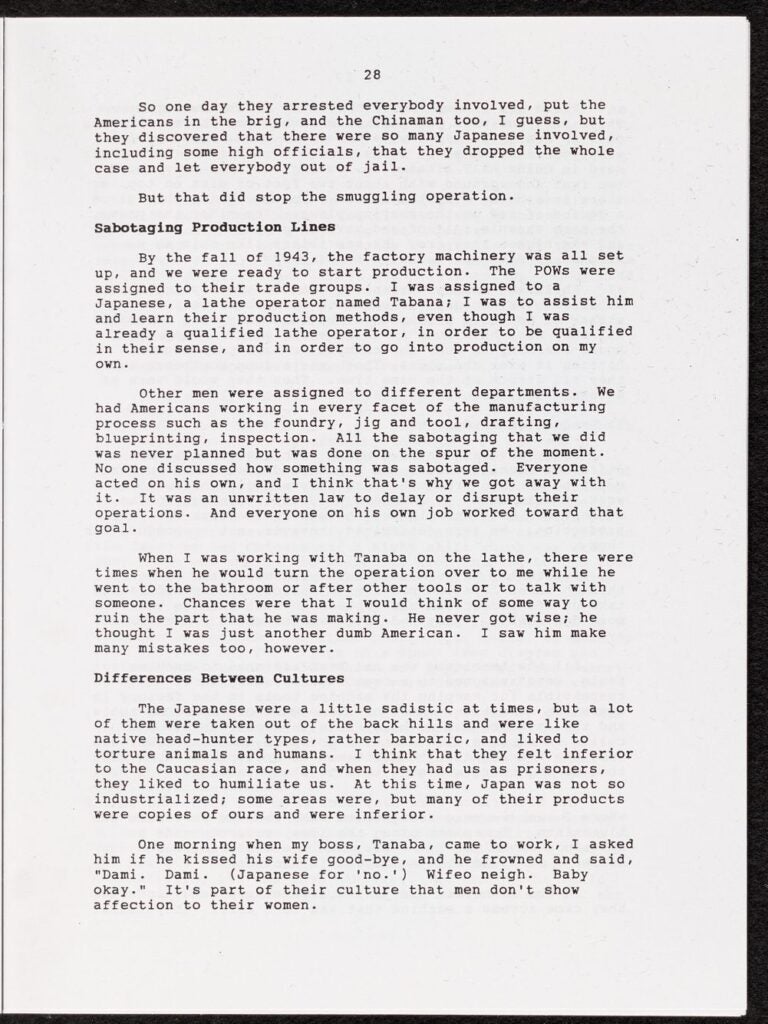Resilience Behind Enemy Lines: The Story of Vernon G. LaHeist and other American POWs in World War II
Remembrance and Records: World War II Through Archival Collections
Warning: The following content features accounts of war and human suffering. Content may be upsetting to some.
Over the next year, in commemoration of the 80th anniversary of the end of World War II, Joyner Library Special Collections will be highlighting items from the East Carolina Manuscripts Collection that relate to the conflict and the individuals who served.
American Prisoners of War
During World War II, a conflict from 1939 to 1945, it is estimated that approximately 120,000 to 130,000 American servicemen were held as prisoners of war by the Axis powers. According to the National Park Service, 94,000 Americans were imprisoned on the European front while the Japanese captured an additional 30,000 troops and civilian workers in the Pacific Theater. The experiences of American POWs during World War II are a testament to human resilience and the will to survive despite overwhelming odds.
The Journey to Captivity
American involvement in World War II began in earnest after the Japanese attack on Pearl Harbor on December 7, 1941. As American forces were deployed across Europe and the Pacific, the chances of capture by enemy forces became a harsh reality.
In Europe, many American soldiers were captured during major campaigns, such as the Battle of the Bulge and the North African Campaign, or were captured after their aircraft were shot down during combat or reconnaissance missions. Meanwhile, in the Pacific, the fall of Bataan and Corregidor in the Philippines led to the capture of thousands of American soldiers by Japanese forces with some 40 percent dying in captivity.
Vernon G. LaHeist
Vernon G. LaHeist was one of many American soldiers who were captured and imprisoned by the Japanese military. Having initially enlisted in the United States Navy in 1933, LaHeist re-enlisted in 1939 following a brief stint working for the Works Progress Administration. After being assigned to duty aboard the USS Finch, LaHeist participated in the defense of Corregidor, a strategically important island located in Manila Bay in the southwestern region of Luzon in the Philippines. On May 6, 1942, the Japanese military overwhelmed the combined forces of the United States and the Commonwealth of the Philippines en route to capturing the island stronghold and taking thousands of soldiers prisoner, including LaHeist. In a memoir entitled Three Years, Three Months, and Nine Days, LaHeist recalls his time as a prisoner of war in camps in both the Philippines and Manchuria.
Conditions in POW Camps
The treatment and conditions experienced by American POWs varied significantly depending on their captors. In Europe, German POW camps,

Vernon LaHeist’s memoir describes the prison camp and conditions that American POWs were forced to live in. U.S. Navy Memorial Foundation Collection: Vernon G. LaHeist Papers (#677-026), East Carolina Manuscript Collection, J. Y. Joyner Library, East Carolina University, Greenville, North Carolina, USA.
known as Stalags for enlisted men and Oflags for officers, conditions were brutal but still regulated by the Geneva Convention. Prisoners faced overcrowding, inadequate food, and forced labor, but they were not subjected to systematic torture or execution.
Conversely, the conditions in Japanese POW camps were notoriously brutal. The Japanese military did not adhere to the Geneva Convention, and POWs were subjected to inhumane treatment, including severe physical abuse, starvation, and forced labor. One of the most infamous events was the Bataan Death March, where thousands of American and Filipino soldiers were forced to march over 60 miles under extreme conditions, leading to the death of thousands.
In his memoir, LaHeist goes into detail explaining the conditions of the camps and the brutality that the men imprisoned in them suffered. LaHeist describes how he and his fellow prisoners suffered through the lack of needed nutrition and food and were forced to live and work in extremely unsanitary conditions, all resulting in the rapid spread of disease that led to a high death rate among imprisoned soldiers. While difficult to read at times, LaHeist’s account of camp conditions offers an invaluable glimpse into the horrors that POWs were forced to endure.
Resilience and Resistance
Despite the dire circumstances, American POWs exhibited remarkable resilience. In German camps, prisoners formed clandestine organizations to boost morale, distribute contraband like news and letters, and plan escapes. The “Great Escape” from Stalag Luft III, where 76 Allied airmen tunneled out of the camp, stands as a legendary act of defiance and bravery.
In the Pacific, survival often depended on solidarity and resourcefulness. POWs shared scarce resources, devised ways to communicate secretly, and maintained hope through camaraderie. Some POWs even participated in covert resistance activities, sabotaging Japanese operations whenever possible.

Vernon LaHeist’s memoir recalls the attempted escape of four Americans from the prison and their eventual recapture and execution by the Japanese. U.S. Navy Memorial Foundation Collection: Vernon G. LaHeist Papers (#677-026), East Carolina Manuscript Collection, J. Y. Joyner Library, East Carolina University, Greenville, North Carolina, USA.
Throughout his memoir, LaHeist’s writing tells the story of American soldiers who despite their imprisonment, still attempted to hold on to hope and resilience for their survival as well as Allied victory in the war. One particularly striking moment from LaHeist’s writings is his recalling of a failed escape attempt of four prisoners who the Japanese unfortunately recaptured. As punishment for their attempt, the four men were tortured and eventually executed by the camp guards. Following this, prisoners were grouped into groups of ten and told that if any member of their group attempted to escape, all ten men would be executed.
Despite these atrocities carried out by the Japanese camp guards, imprisoned soldiers still attempted to keep their spirits up through a variety of different means. LaHeist talks about how several prisoners would lead religious services, some smuggled materials to create rough musical instruments, and many others played games and gambled despite the men having nothing to spare.

Vernon LaHeist’s memoir details how despite their dire situation, imprisoner American servicemen still took it upon themselves to sabotage Japanese military efforts, despite the danger this brought. U.S. Navy Memorial Foundation Collection: Vernon G. LaHeist Papers (#677-026), East Carolina Manuscript Collection, J. Y. Joyner Library, East Carolina University, Greenville, North Carolina, USA.
The most interesting part of LaHeist’s writings is when he discusses how he and other prisoners assigned to work in factory machinery took it upon themselves to sabotage the tools and parts being made to continue helping the war effort. The way that imprisoned soldiers attempted to support their fellow soldiers on the frontlines by purposely sabotaging enemy supplies at the risk of their own lives is inspiring.
Liberation and Aftermath
The end of World War II in 1945 brought liberation for many American POWs. In Europe, advancing Allied forces liberated German camps. In the Pacific, the surrender of Japan led to the release of thousands of POWs. The joy of freedom, however, was tempered by the physical and psychological scars left by their experiences.
LaHeist and his fellow imprisoned soldiers were liberated by Russian forces following the surrender of the Japanese in the summer of 1945. Following the end of the war, LaHeist explains how the prison camp was supplied by American forces dropping food, clothing, and other needed supplies to the soldiers as they awaited the arrival of the Russian military. LaHeist finally left the camp for good in September 1945 and details his journey back home, reaching American soil in October 1945 after being away for over six years.
Legacy and Remembrance
The story of American POWs in World War II is a powerful reminder of the sacrifices made by soldiers and the human capacity for endurance in the face of unimaginable hardship. Their experiences have been documented in numerous memoirs, films, and scholarly works, ensuring that their stories continue to be remembered and honored.
Institutions like the National WWII Museum and the American Ex-Prisoners of War organization play crucial roles in preserving the legacy of POWs. Memorials and commemorative events also serve as poignant reminders of their courage and the cost of war.
In remembering American POWs of World War II, we honor their suffering, their strength, and their unyielding spirit. Their stories are not just a part of military history but a testament to the enduring human will to survive and overcome adversity.
Visit the Ship’s Log, as well as Joyner Library’s social media channels, to learn more about materials related to World War II that are a part of the East Carolina Manuscripts Collection’s holdings. Joyner Library Special Collections will be displaying an exhibit of items and individual stories related to World War II during the summer and fall of 2025.
